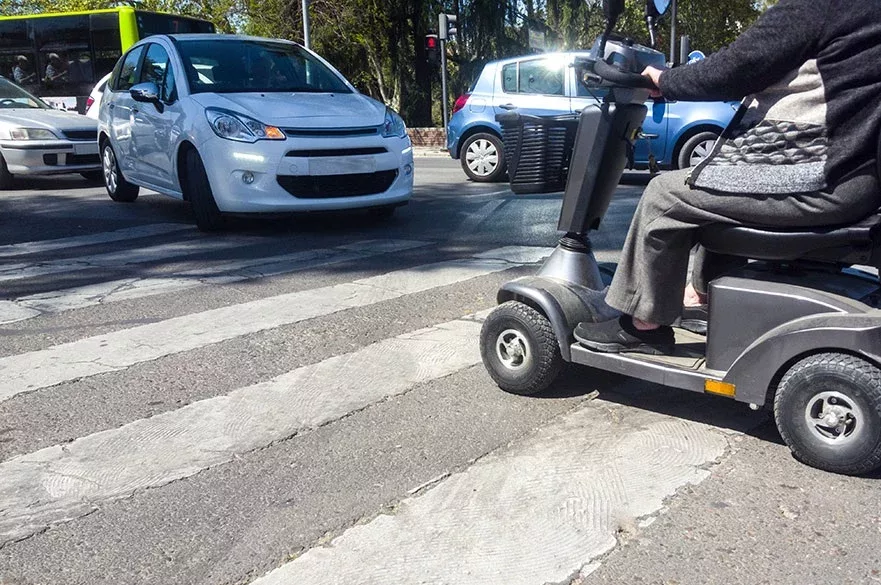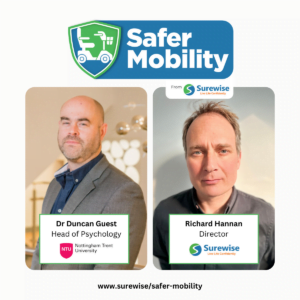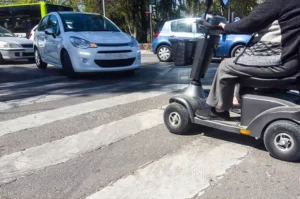The largest ever study of more than 250 motorised mobility scooter users by Nottingham Trent University is highlighting and identifying a core set of real-world hazards encountered by users and the strategies that users of all experience levels utilise to make their experience safer.
Of those questioned, around 62% had not received any form of training and of the 38% who had, most had received training around vehicle handling. Very few received training about the hazards they would face, with only 8% attending training on an inside course or completing outdoor training or observation.
This is despite findings showing that scooter riders are significantly impacted by the design of roads and crossings which have narrow central areas, difficult to reach buttons, inadequate drop kerbs, short crossing times and obstructions that can limit visibility – as well as simply being in complex environments with a mix of pedestrian and road users while having restricted mobility.
As well as facing narrow and bumpy pavements, often with potholes, they also reported regularly encountering difficult to navigate obstacles on the pavement such as parked cars, wheelie bins and shop signs.
Mobility scooter users also found other pedestrians were a significant issue as they were seen to be unpredictable. Many users felt that people are often unaware of when a mobility scooter is nearby and will walk in front of the vehicle. This exacerbated a feeling among the riders of being ignored or treated with hostility by other road users who consider them a nuisance.
With a lack of hazard perception-focused training available users had developed their own strategies, such as focusing on assessing hazardous situations carefully, modifying their speed, waiting until a hazardous situation had passed, being vigilant of their surroundings, ensuring they are visible, learning to position their scooter in particular ways at particular crossings, planning their route in advance, or taking an alternative route. A small number also said they had stopped going out on their mobility scooter at certain times.
Lead researcher from NTU’s School of Sciences, Dr Duncan Guest, said: “The users in our study were very clear that their scooters improved their quality of life, self-esteem, mental wellbeing and physical health, as well as giving them greater independence. However, there were frustrations over access difficulties and the structure of roads and pavements, which create hazards for both users and others around them.
“Users also felt others had quite negative attitudes towards them. Some of the stigma they face may come from a lack of understanding about the issues that motorised mobility scooter users face and why they behave in a certain way. However, it could also point to inconsistencies in scooter behaviour due to a lack of training. Both of these factors may contribute to accidents or close calls.
“Despite this, we found that the majority of scooter riders felt safe when using their mobility scooter (81%) and were actually more concerned with the safety of other road users. Interestingly 90% of users felt more could be done to promote the safe use of motorised mobility scooters and were in favour of options such as compulsory training and hazard awareness training.”
The research findings have led to the creation of the first evidence-based hazard awareness training for motorised mobility scooter. The See & Scoot Mobility Scooter Training Resource uses real life footage filmed from a scooter user’s perspective as they drive around a city centre route. It was developed by the Transport Research in Psychology group at NTU as part of a two-year research grant from the Road Safety Trust.
Ruth Purdie OBE, chief executive of The Road Safety Trust, said: “Motorised mobility scooters play an important role in many people’s lives, providing greater independence and freedom.
“However, as this study has pointed out, they receive very little training about the types of hazards they might face.
“We are delighted to see the findings have been turned into the development of the first evidence-based hazard awareness training for motorised mobility scooter users, a resource which will help improve both their confidence and safety.”
The full research report has been published by the journal Accident Analysis and Prevention.
(Picture – Nottingham Trent University)





















